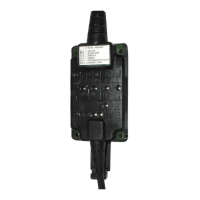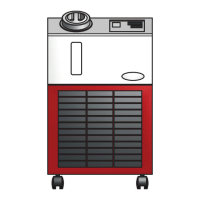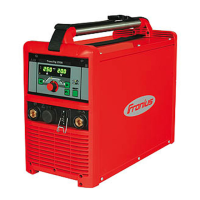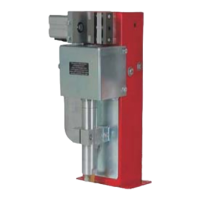In the case of power cables with a bayonet connector, rotate the power cable
around the longitudinal axis by at least 180° and pretension.
Do not wrap cables or leads around the body or parts of the body.
The electrode (rod electrode, tungsten electrode, welding wire, etc.) must
-
never be immersed in liquid for cooling
-
Never touch the electrode when the power source is switched on.
Double the open circuit voltage of a power source can occur between the welding
electrodes of two power sources. Touching the potentials of both electrodes at
the same time may be fatal under certain circumstances.
Arrange for the mains cable to be checked regularly by a qualified electrician to
ensure the ground conductor is functioning properly.
Protection class I devices require a mains supply with ground conductor and a
connector system with ground conductor contact for proper operation.
Operation of the device on a mains supply without ground conductor and on a
socket without ground conductor contact is only permitted if all national regula-
tions for protective separation are observed.
Otherwise, this is considered gross negligence. The manufacturer shall not be
held liable for any damage arising from such usage.
If necessary, provide adequate earthing for the workpiece.
Switch off unused devices.
Wear a safety harness if working at height.
Before working on the device, switch it off and pull out the mains plug.
Attach a clearly legible and easy-to-understand warning sign to the device to
prevent anyone from plugging the mains plug back in and switching it on again.
After opening the device:
-
Discharge all live components
-
Ensure that all components in the device are de-energised.
If work on live parts is required, appoint a second person to switch off the main
switch at the right moment.
EMC measures In certain cases, even though a device complies with the standard limit values for
emissions, it may affect the application area for which it was designed (e.g. when
there is sensitive equipment at the same location, or if the site where the device
is installed is close to either radio or television receivers).
If this is the case, then the operator is obliged to take appropriate action to recti-
fy the situation.
Check and evaluate the immunity to interference of nearby devices according to
national and international regulations. Examples of equipment that may be sus-
ceptible to interference from the device include:
-
Safety devices
-
Network, signal and data transfer lines
-
IT and telecommunications devices
-
Measuring and calibrating devices
Supporting measures for avoidance of EMC problems:
1.
Mains supply
-
If electromagnetic interference arises despite the correct mains connec-
tion, additional measures are necessary (e.g. use of a suitable line filter)
39
EN
